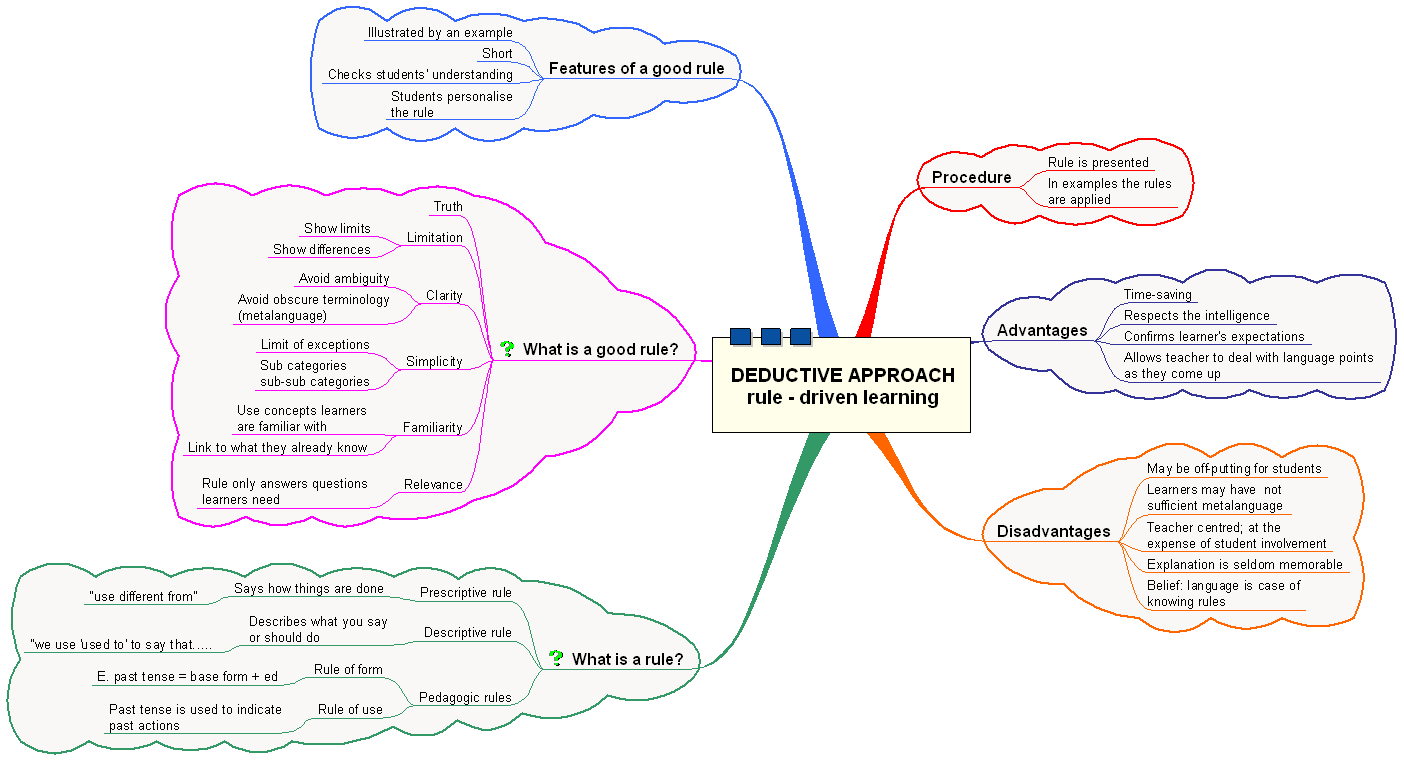
PRESENTING GRAMMAR
APPROACHES

A) The deductive approach – rule driven learning
A deductive approach starts with the presentation of a rule and is followed by examples in which the rule is applied.
The grammar rule is presented and the learner engages with it through the study and manipulation of examples.
Advantages of a deductive approach:
· It gets straight to the point, and can therefore be time-saving. Many rules — especially rules of form — can be more simply and quickly explained than elicited from examples. This will allow more time for practice and application.
· It respects the intelligence and maturity of many - especially adult -students, and acknowledges the role of cognitive processes in language acquisition.
· It confirms many students' expectations about classroom learning, particularly for those learners who have an analytical learning style.
· It allows the teacher to deal with language points as they come up, rather than having to anticipate them and prepare for them in advance.
Disadvantages of a deductive approach:
· Starting the lesson with a grammar presentation may be off-putting for some students, especially younger ones. They may not have sufficient metalanguage (i.e. language used to talk about language such as grammar terminology). Or they may not be able to understand the concepts involved.
· Grammar explanation encourages a teacher-fronted, transmission-style classroom; teacher explanation is often at the expense of student involvement and interaction.
· Explanation is seldom as memorable as other forms of presentation, such as demonstration.
· Such an approach encourages the belief that learning a language is simply a case of knowing the rules.
What is a rule:?
In the Longman Activity Dictionary “rule” is defined as:
· a principle or order which guides behaviour, says how things are to be done etc, (prescriptive rule)
· the usual way that something happens ( descriptive rule). Descriptive rules are primarily concerned with generalisations about what speakers of the language actually do say than what they should do.
Pedagogic rules – they make sense to learners and provide them with the means and confidence to generate language with a reasonable chance of success.
Pedagogic rules can be spit up into:
rules of form and rules of use.
Examples of prescriptive rules:
Do not use different to and never use different than. Always use different from.
Never use the passive when you can use the active.
Use shall for the first person and will for second and third persons.
Examples of descriptive rules:
You do not normally use the with proper nouns referring to people.
We use used to with the infinitive (used to do, used to smoke etc.) to say that something regularly happened in the past but no longer happens.
Example for rule of form:
To form the past simple of regular verbs, add –ed to the infinitive.
Example of a rule of use:
The simple past tense is used to indicate past actions or states.
Example: (from Walker and Elsworth Grammar practice for Intermediate Students, Longman, 1986)

Many of the pros and cons of a rule-driven approach hinge on the quality of the actual rule explanation. This in turn depends on how user-friendly the rule is.
What makes a rule a good rule? Michael Swan, author of teachers' and students' grammars, offers the following criteria:
• Truth: Rules should be true. While truthfulness may need to be compromised in the interests of clarity and simplicity, the rule must bear some resemblance to the reality it is describing.
It is surprising how many incorrect explanations you find in TEFL books. A good example is the distinction usually made between some and any, which goes something like:
Use some+plural countable/uncountable noun in affirmative sentences.Use any+plural countable/uncountable noun in negative sentences and questions.
It still fails to explain:
Take any one you want.I didn't like some of his books.
An explanation based on the difference in meaning between some and any might eliminate many of these problems.
• Limitation: Rules should show clearly what the limits are on the use of a given form.
For example, to say simply that we use will to talk about the future is of little use to the learner since it doesn't show how will is different from other ways of talking about the future (e.g. going to).
• Clarity: Rules should be clear. Lack of clarity is often caused by ambiguity or obscure terminology.
For example: 'Use will for spontaneous decisions; use going to for premeditated decisions.' To which a student responded, 'All my decisions are premeditated'.
• Simplicity: Rules should be simple. Lack of simplicity is caused by overburdening the rule with sub-categories and sub-sub-categories in order to cover all possible instances and account for all possible exceptions. There is a limit to the amount of exceptions a learner can remember.
• Familiarity: An explanation should try to make use of concepts already familiar to the learner. Few learners have specialised knowledge of grammar, although they may well be familiar with some basic terminology used to describe the grammar of their own language (e.g. conditional, infinitive, gerund). Most learners have a concept of tense (past, present, future), but will be less at home with concepts such as deontic and epistemic modality, for example.
• Relevance: A rule should answer only those questions that the student needs answered. These questions may vary according to the mother tongue of the learner. For example, Arabic speakers, who do not have an equivalent to the present perfect, may need a different treatment of this form than, say, French speakers, who have a similar structure to the English present perfect, but who use it slightly differently.
A lot depends on the teacher’s presentation of the rule. An effective rule presentation will include the following features:
it will be illustrated by an example
It will be short
Students’ understanding will be checked
Students will have an opportunity to personalize the rule.